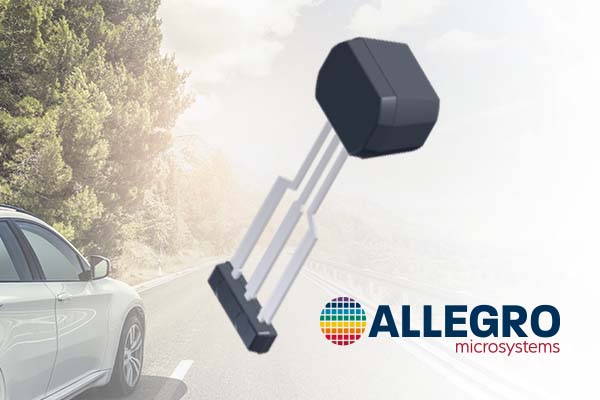Allegro MicroSystems Unveils New GMR Crankshaft And Camshaft Sensors

Allegro MicroSystems, has announced the release of two new state-of-the-art giant magnetoresistance (GMR) crankshaft and camshaft sensors. The ATS16951 (crankshaft) and ATS16351 (camshaft) sensors are unique in the market and provide manufacturers with a single-vendor solution that's ideal for hybrid vehicle engines, with use cases extending to two-wheelers, off-road vehicles, and application designs requiring extended air gap performance. Both sensors will help engine designers reduce system complexity, cost, and energy consumption—boosting efficiency and minimising carbon footprints.
While the trend toward full electrification continues to accelerate, recent IHS forecasts predict that 81% of vehicles will include some form of internal combustion engine through 2029, with full and mild hybrids being the most common. Engine architectures are changing as part of the shift toward smaller hybrid designs, and sensor accuracy and positioning flexibility are becoming more important than ever before.
With up to 40% better edge repeatability and lower amounts of jitter compared to competing and legacy solutions, the ATS16951 back-biased GMR crankshaft sensor gives automakers new ways to increase fuel efficiency with higher-precision ignition and valvetrain timing. Its large air gap simplifies design-in, expands design margin and tolerance capability, and facilitates a wider range of sensor installation locations.
With an industry-leading air gap that's 50% larger than existing options, the ATS16351 True Power On State (TPOS) GMR camshaft sensor also improves both design-in flexibility and stray field immunity. It can be placed virtually anywhere, which is increasingly important as some hybrid engines now include four camshaft sensors. Tight spaces often combine with high current transients, and engine designers need camshaft sensors that work seamlessly through the resulting stray fields. The ATS16351's differential GMR architecture provides a level of immunity not currently available in legacy or competing solutions.
Both sensors include Allegro's Target Profile Diagnostic feature, which makes it possible to assess a target during manufacturing and detect any subtle tooth anomalies before an engine is installed into a vehicle, helping to prevent potential warranty returns and increasing customer satisfaction.
“Our new GMR crankshaft and camshaft sensors optimise performance for emerging hybrid vehicle applications. They're unique to the market and outperform competing technologies due to their high air gaps and level of accuracy,” says Peter Wells, Speed and Sensor Interface Business Line Director at Allegro. “The industry is transitioning to xEVs quickly, and the ATS16951 and ATS16351 both offer a level of precision that will help give automakers the increases in motor efficiency they're targeting.”
High Integration and Superior Algorithms Drive Performance
Combining advanced GMR technology with leading automotive-grade algorithms and packaging technology, Allegro now offers a cutting-edge, comprehensive engine sensor portfolio that addresses the needs of today's system developers and manufacturers.
The ATS16951 combines the electrical requirements and package size of legacy solutions with sensing location flexibility, making it a drop-in replacement for existing Hall-effect crankshaft sensors and simplifying design reuse. It includes a programmable pulse location between the center or edge of the target feature, along with EEPROM-programmable performance optimisations and production traceability.
The ATS16351 is also highly programmable, allowing manufacturers to optimise the TPOS performance to the widest variety of engine designs.
Monolithic integration makes it possible for both sensors to achieve exceptional in-system performance and highly accurate speed and position detection. The fully integrated, single overmold package common to both devices helps designers reduce design complexity and simplify the development process, and allows suppliers to standardise production lines. Enabling flexible design-in and system compensation, the three-pin single inline package (SIP) houses the IC, magnet, and EMC protection components. The precision assembly optimises IC-to-magnet positioning, as reduced tolerance stack between the IC and magnet increases sensor accuracy and leaves ample margin for in-application installation tolerance.
The ATS16951 was developed in accordance with ISO 26262 as a safety element out of context targeting ASIL B capability (pending assessment) for use in automotive safety-related systems when integrated and used in the manner prescribed in the applicable safety manual and datasheet.

The leading global integrated photonics conference and exhibition will once again bring together key players from across the value chain for two-days of strategic technical sessions, dynamic talks and unrivalled networking opportunities.
Join us face-to-face on 28th – 29th June 2022
- View the agenda.
- 3 for the price of 1. Register your place and gain complementary access to TWO FURTHER industry leading conferences: CS International and PIC International.
- Email info@sensorsinternational.net or call +44 (0)24 7671 8970 for more details.
*90% of exhibition space has gone - book your booth before it’s too late!



























